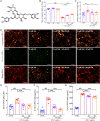Forsythoside A Mitigates Alzheimer's-like Pathology by Inhibiting Ferroptosis-mediated Neuroinflammation via Nrf2/GPX4 Axis Activation
- PMID: 35342364
- PMCID: PMC8935224
- DOI: 10.7150/ijbs.69714
Forsythoside A Mitigates Alzheimer's-like Pathology by Inhibiting Ferroptosis-mediated Neuroinflammation via Nrf2/GPX4 Axis Activation
Abstract
Ferroptosis and neuroinflammation play crucial roles in Alzheimer's disease (AD) pathophysiology. Forsythoside A (FA), the main constituent of Forsythia suspensa (Thunb.) Vahl., possesses anti-inflammatory, antibacterial, antioxidant, and neuroprotective properties. The present study aimed to investigate the potential role of FA in AD neuropathology using male APP/PS1 double transgenic AD mice, Aβ1-42-exposed N2a cells, erastin-stimulated HT22 cells, and LPS-induced BV2 cells. FA treatment significantly improved mitochondrial function and inhibited lipid peroxidation in Aβ1-42-exposed N2a cells. In LPS-stimulated BV2 cells, FA treatment decreased the formation of the pro-inflammatory factors IL-6, IL-1β, and NO. In male APP/PS1 mice, FA treatment ameliorated memory and cognitive impairments and suppressed Aβ deposition and p-tau levels in the brain. Analyses using proteomics, immunohistochemistry, ELISA, and western blot revealed that FA treatment significantly augmented dopaminergic signaling, inhibited iron deposition and lipid peroxidation, prevented the activation of IKK/IκB/NF-κB signaling, reduced the secretion of pro-inflammatory factors, and promoted the production of anti-inflammatory factors in the brain. FA treatment exerted anti-ferroptosis and anti-neuroinflammatory effects in erastin-stimulated HT22 cells, and the Nrf2/GPX4 axis played a key role in these effects. Collectively, these results demonstrate the protective effects of FA and highlight its therapeutic potential as a drug component for AD treatment.
Keywords: Alzheimer's disease; Nrf2/GPX4 axis; ferroptosis; forsythoside A; neuroinflammation; neuroprotection.
© The author(s).
Conflict of interest statement
Competing Interests: The authors have declared that no competing interest exists.
Figures







Similar articles
-
Eriodictyol ameliorates cognitive dysfunction in APP/PS1 mice by inhibiting ferroptosis via vitamin D receptor-mediated Nrf2 activation.Mol Med. 2022 Jan 29;28(1):11. doi: 10.1186/s10020-022-00442-3. Mol Med. 2022. PMID: 35093024 Free PMC article.
-
Forsythoside B attenuates memory impairment and neuroinflammation via inhibition on NF-κB signaling in Alzheimer's disease.J Neuroinflammation. 2020 Oct 15;17(1):305. doi: 10.1186/s12974-020-01967-2. J Neuroinflammation. 2020. PMID: 33059746 Free PMC article.
-
The anti-Alzheimer's disease effects of ganoderic acid A by inhibiting ferroptosis-lipid peroxidation via activation of the NRF2/SLC7A11/GPX4 signaling pathway.Chem Biol Interact. 2025 May 1;412:111459. doi: 10.1016/j.cbi.2025.111459. Epub 2025 Mar 5. Chem Biol Interact. 2025. PMID: 40054827
-
Astragaloside IV regulates the ferroptosis signaling pathway via the Nrf2/SLC7A11/GPX4 axis to inhibit PM2.5-mediated lung injury in mice.Int Immunopharmacol. 2022 Nov;112:109186. doi: 10.1016/j.intimp.2022.109186. Epub 2022 Sep 15. Int Immunopharmacol. 2022. PMID: 36115280 Review.
-
Striking a NRF2: The Rusty and Rancid Vulnerabilities Toward Ferroptosis in Alzheimer's Disease.Antioxid Redox Signal. 2023 Jul;39(1-3):141-161. doi: 10.1089/ars.2023.0318. Antioxid Redox Signal. 2023. PMID: 37212212 Review.
Cited by
-
The Ferroptosis Inhibitor Liproxstatin-1 Ameliorates LPS-Induced Cognitive Impairment in Mice.Nutrients. 2022 Nov 1;14(21):4599. doi: 10.3390/nu14214599. Nutrients. 2022. PMID: 36364859 Free PMC article.
-
Natural antioxidants that act against Alzheimer's disease through modulation of the NRF2 pathway: a focus on their molecular mechanisms of action.Front Endocrinol (Lausanne). 2023 Jul 3;14:1217730. doi: 10.3389/fendo.2023.1217730. eCollection 2023. Front Endocrinol (Lausanne). 2023. PMID: 37465125 Free PMC article. Review.
-
The mechanism of ferroptosis in early brain injury after subarachnoid hemorrhage.Front Immunol. 2023 May 17;14:1191826. doi: 10.3389/fimmu.2023.1191826. eCollection 2023. Front Immunol. 2023. PMID: 37266433 Free PMC article. Review.
-
Origins of nervous tissue susceptibility to ferroptosis.Cell Insight. 2023 Mar 27;2(3):100091. doi: 10.1016/j.cellin.2023.100091. eCollection 2023 Jun. Cell Insight. 2023. PMID: 37398634 Free PMC article. Review.
-
Role of Nrf2 in Oxidative Stress, Neuroinflammation and Autophagy in Alzheimer's Disease: Regulation of Nrf2 by Different Signaling Pathways.Curr Mol Med. 2025;25(4):372-387. doi: 10.2174/1566524023666230726145447. Curr Mol Med. 2025. PMID: 37493162 Review.
References
Publication types
MeSH terms
Substances
LinkOut - more resources
Full Text Sources
Medical

